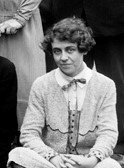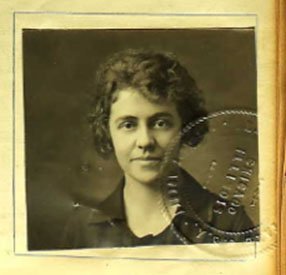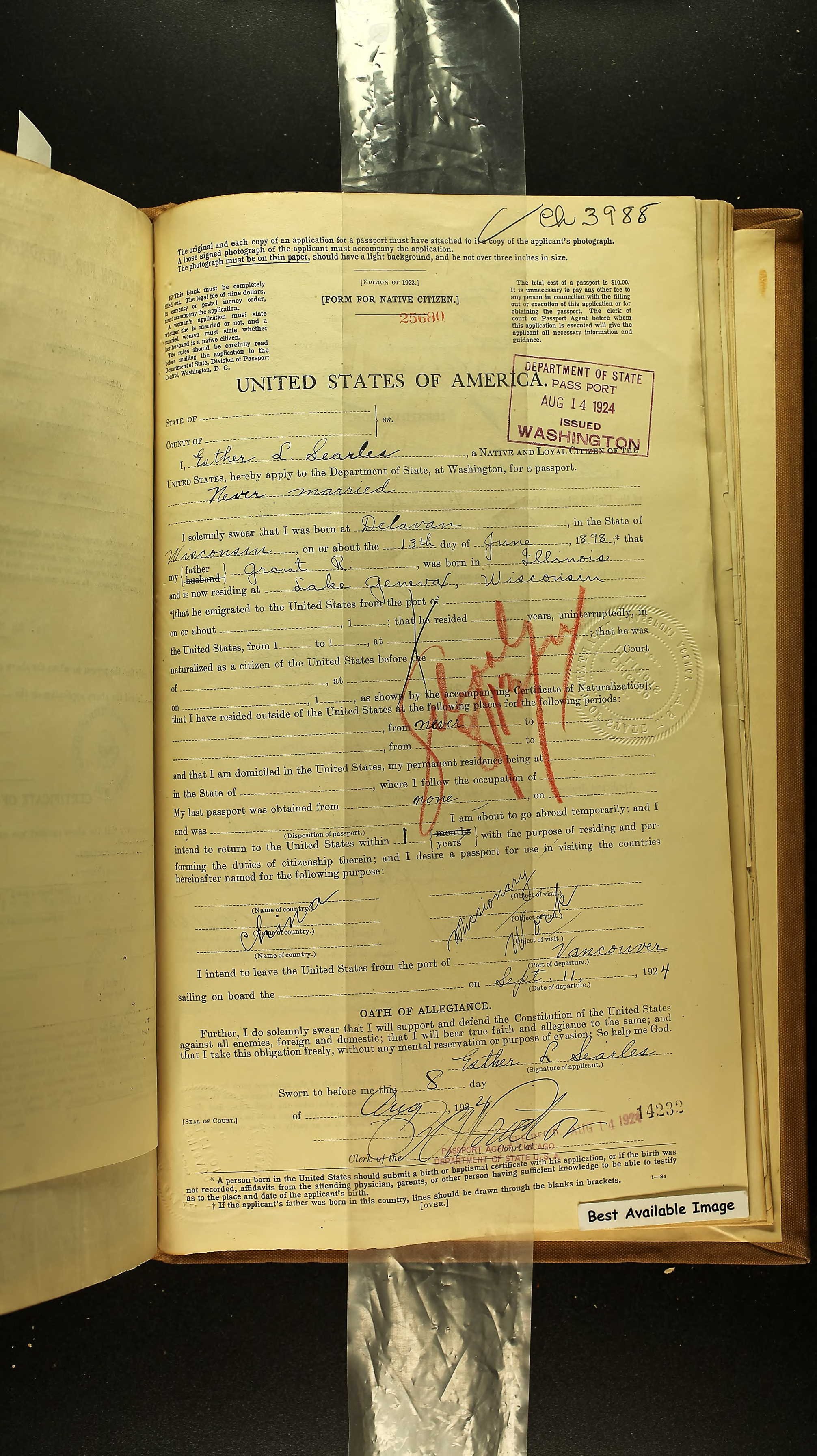Esther L. Searles (c. 1899–1983)

University of Chicago Photographic Archive, [apf6-00447], Hanna Holborn Gray Special Collections Research Center, University of Chicago Library.
http://photoarchive.lib.uchicago.edu/db.xqy?one=apf6-00450.xml
While her skills as a typist earned her a job at Yerkes, Esther Searles's competence enabled her to use Yerkes as a springboard for bigger and better things, from Shanghai to the University of Michigan.
Esther Louise Searles grew up at 204 South Seventh Street in Delavan, Wisconsin, just a few miles from Yerkes Observatory.[1 and Note] As a high school student, she was an active member of the Y.M.C.A. girls’ basketball team and the Baptist Young People’s Society.[2] She excelled as a typist and earned an “efficiency certificate” at the age of 16 from the Remington Typewriter Company for typing 47 words per minute in a speed test.[3] After graduating from Lake Geneva High School in 1916, Searles attended Hillsdale College in Michigan, where she became an active member of the Y.W.C.A. and the Germanae Sodales literary society. She left Hillsdale before completing her BA and returned to Wisconsin, where she lived in Lake Geneva with her parents and three younger siblings.[4]
Early career
By January 1920, Searles was working at Yerkes Observatory as a stenographer. During her time at the observatory, she worked primarily for the Astronomer and University of Chicago Professor John Adalbert Parkhurst (1861-1925) who specialized in photometry – the study of measuring light from stars.[5] Parkhurst did not acknowledge Searles by name for her assistance in any of the seventeen publications that appeared after her arrival at Yerkes, but others did commend her support of the scientific work of the Observatory. In her Ph.D. dissertation, Harriet M. Parsons writes, “Miss Esther Searles has been of great assistance in the computations.” [6] Searles returned to college in September 1921, this time attending DePauw University in Greencastle, Indiana. She continued working at Yerkes over the summers and after graduating in 1923, she accepted a temporary position as Parkhurst’s personal secretary.[7] She left Yerkes again in September that same year to begin her new job as a science teacher at the Senior High School in Brazil, Indiana, where she was supervisor of Botany.[8]
Whether she decided that a teacher’s life was not for her or found a new opportunity irresistible is unclear, but Searles did not remain a teacher for long. On Thursday, September 11, 1924, Searles set sail for China from Vancouver, Canada, as part of a Methodist Episcopal Church group. In Shanghai she worked as a secretary in the office of Dr. Frank D. Gamewell, General Secretary of the China Christian Educational Association. Gamewell was famous for coordinating the defense of American and British missionaries, as well as many Chinese Christians, during the Yihetuan Movement in 1900. It was also during her time in China that Searles first met her future spouse, Joe D. Brooks.
Searles returned to the United States, and appears in the Yerkes Observatory summer staff photo in 1927. By October 1927 she was working first as a Clerk and then as Stenographer in the Bureau of Appointments at the University of Michigan. It was a well-paid position, and in less than a year, she had advanced to become a Statistical Assistant (perhaps using her computation experience) working in both the Registrar’s office and the Bureau of University Research, with a further increase in salary.
Joe Brooks, in the meantime, had remained in China. He returned to the United States in June 1929 and Searles and Brooks married in Michigan on December 23, 1929. Listed as a “farm laborer” in the 1920 US Census, by 1929 Brooks had become a Chemist. This qualification helped him obtain employment at Bemberg and Glanzstoff rayon mills in Elizabethton, in his native Tennessee, where he and Searles/Brooks moved immediately after their wedding.
As happened for many of the women of Yerkes, marriage – and the birth of at least three children – ended Searles/Brooks independent career. However, this in no way diminishes her accomplishments as a woman or the importance of her work at Yerkes for the advancement of science. Searles was a career woman whose skill and competence were clearly recognized by her employers. Yet because she was a woman, her career trajectory was severely limited in the early twentieth century by cultural, social, and economic factors. After her marriage, she was expected (if not required) to quit her job at the University of Michigan. Few women with the honorific “Mrs.” are included in the institution’s lists of employees from this period. It is also evident by comparison with her husband’s career. For while Brooks’ salary in 1940 was $2,000 – not that much more than Searles had been making ten years earlier as a single woman in Michigan – by 1950 he was making triple that. As a man, Brooks had access to the kind of upward professional economic mobility that was closed to the overwhelming majority of women at the time – no matter how talented.
Footnotes:
NOTE: Names for women during the time they are unmarried use their family or birth last name; references to the women in the time following a marriage use the convention "unmarried last name/married last name," e.g., Block/Paraskevopoulos. [back]
[1] 1910 U.S. Census [back]
[2] Contemporary local newspapers provide details of Esther's early life. For example: “Literary Entertainment.” Lake Geneva News (Thursday, May 20, 1915): 4; “Y.M.C.A. Athletics. Cardinals Defeat Janesville at Basketball – Games with Genoa Junction – Girls’ Scores,” The Lake Geneva Herald (Friday, December 10, 1915): 6; “Y.M.C.A. Activities,” Lake Geneva News (Thursday, February 3, 1916): 1. (via newspapers.com Lake Geneva Regional News). [back]
[3] “Notes from the Commercial Department,” Lake Geneva News (Thursday, November 11, 1915): 1 (via newspapers.com Lake Geneva Regional News). [back]
[4] 1920 U.S. Census. [back]
[5] Per working as Parkhurst’s secretary in Summer 1923: “Williams Bay,” Lake Geneva News (Thursday, June 28, 1923): 8 (via newspapers.com, Lake Geneva Regional News). [back]
[6] Harriet McWilliams Parsons, "Astrometric and Photometric Statistics of Certain of Hagen’s Fields,” Publications of the Yerkes Observatory, Vol. 4 (1926): 32. [back]
[7] Per originally working with Parkhurst: “Personal and Local Items,” Lake Geneva News (Thursday, January 29, 1920): 1. Per working as Parkhurst’s secretary in Summer 1923: “Williams Bay,” Lake Geneva News (Thursday, June 28, 1923): 8 (via newspapers.com, Lake Geneva Regional News). [back]

